Regrets can derail a career. For Bas Timmer they were a turning point. A young Dutch fashion designer just out of school in 2014, Timmer was embarking on a promising direction as a cold weather-gear specialist when he stumbled over a homeless man one cold night. He thought about giving the man one of his signature fashion hoodies, but—to his lasting shame—paused for fear of diminishing his brand. A few months later a friend’s father, also homeless, died of hypothermia. “I felt guilty,” says Timmer. “I had the opportunity to help, and I did nothing.”
To make up for it, he dedicated his brand to helping others. Rejecting his first idea of hoodies for the homeless as not good enough, he designed around the requirements for life on the streets: waterproof, warm, portable and good for sleeping. Part tent and part parka, Timmer’s “sheltersuit” featured a detachable sleeping bag that could be zipped off and easily stored during the day. He presented his mashup to a local homeless man, who was enchanted. “He said, ‘I have two friends, can I share my jacket with them?’ And I said ‘no, this one is yours. Let me see if I can make two more.’ And that’s when the whole Sheltersuit idea started.”

Six years later, Timmer, 30, is still handing out Sheltersuits. So far he has distributed 12,500 to homeless people in the UK, the Netherlands, Germany, Italy, the U.S. and to refugees in Greece. He has adapted his designs to local conditions, with less insulation in warmer areas. He has inserted Velcro closures at the foot of the sleeping bags so that wearers have more freedom for their feet (important in areas where the homeless are routinely harassed by police and often need to run). The suits are made out of donated and upcycled materials, and manufacturing costs are covered by donations. To bring costs down further, Timmer is expanding to South Africa, where he has partnered with UNICEF to produce the suits for worldwide distribution at much lower costs—around $30 a piece. His goal is to open similar small factories all over the world, empowering local communities by teaching people to sew the designs and giving them a livelihood in the process. Timmer is aware that his invention is no solution for homelessness, which he knows is not going to go away anytime soon, especially in the wake of economic devastation wreaked by the COVID-19 pandemic. Still, he says, it’s better than doing nothing. “It is a band-aid, but it’s a good band-aid. People want a house; they want a job. Until they have that, let’s at least protect them while they are on the streets.”
Timmer hasn’t entirely given up on his dreams of designing for a commercial brand. Eventually, he says, he wants to create a company as big as North Face, but with a twist: all the profits will fund his Sheltersuit foundation. Donations alone can’t help the world’s 100 million homeless, but a globally recognized brand might. “By selling beautiful products that keep people warm and dry and protected, I can help others stay warm and dry and protected.”
- How Nayib Bukele’s ‘Iron Fist’ Has Transformed El Salvador
- What Makes a Friendship Last Forever?
- How to Read Political Polls Like a Pro
- Long COVID Looks Different in Kids
- What a $129 Frying Pan Says About America’s Eating Habits
- How ‘Friendshoring’ Made Southeast Asia Pivotal to the AI Revolution
- Column: Your Cynicism Isn’t Helping Anybody
- The 32 Most Anticipated Books of Fall 2024